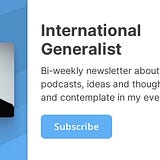What I Took Away From: “Growth Hacker Marketing” by Ryan Holiday
I’ve recently been on a Ryan Holiday binge — after reading his book “Perennial Seller”, I was so impressed with his Marketing stuff that I…

I’ve recently been on a Ryan Holiday binge — after reading his book “Perennial Seller”, I was so impressed with his Marketing stuff that I simply had to dive in deeper. Previously, I had only read his philosophy books “The Obstacle Is The Way” and “Ego Is The Enemy”, which I both loved, but his literature about Marketing was new to me. One of the bottlenecks in our business is always user acquisition, so I wanted to learn a bit more about this whole “growth hacking” thing that everyone is talking about.
The book is called “Growth Hacker Marketing” by Ryan Holiday, and here’s what I took away from it:
Growth Hacking is the new Marketing.
Marketing used to be traditional advertising, direct marketing, and public relations. You put up a billboard or had a TV commercial, spent a ton of money on it, and had absolutely no idea how effective this measure was in terms of actual conversions (meaning, people buying your product or using your service). Holiday compares it to a movie launch: you’d use all kinds of channels, working up to one big event, without actually having an idea how it’s going to turn out.
Then, with the advent of the computer, everything changed. Now, you can actually track the effectiveness of your marketing measures, which in turn allows you to optimize your best channels, and cutting costs where it isn’t necessary. But the key to Growth Hacking is the next point:
Think like an engineer, not like a marketer.
An engineer is always trying to improve the product. A marketer is trying to sell the product. But even the best marketer cannot sell a mediocre product sustainably. An engineer thinks of creative ways in order to solve a user’s problems, which can then lead to new user acquisition.
A few examples:
- AirBNB hosts had trouble renting out their apartments, because few people were looking at the AirBNB listings in the first place. So an engineer wrote some code that’d allow hosts to automatically cross-post to Craigslist, a way bigger platform. With these cross-posts, hosts were able to get a lot more requests for their home, making them happier and in turn driving more users to the service.
- Dropbox users had the trouble of not having enough free space, so Dropbox enabled a feature that you can get more free space by inviting your friends — in turn driving more users to the service. This requires, however, that you already have a great product.
Your product needs to be perfectly adjusted to your market.
This is the ominous “product-market-fit”. Before you can do anything else, you need to make sure that your product is adjusted to your users’ needs. This can be achieved by using iterative processes, such as the “build-measure-learn” loop, popularized in Eric Ries’ “The Lean Startup”. Instead of working on your product in the darkness and then releasing it all the sudden, it’s better to start with something small (a “minimum viable product”) and then slowly work your way towards the bigger features, adding one at a time and constantly testing.
As an example, instead of withdrawing yourself from the public for a year in order to write a book, and then releasing it without having solicited feedback from your actual audience (an remember, an editor is not an audience — nor is your mother), write a blog post first. If that blogpost gets good feedback and questions, work with that in order to write a long-form post about that topic, or a series of posts. If that works well, you can write an ebook.
Once people start downloading the ebook and rating it well, you know you have something — so you can then go ahead and turn it into an actual book! If I ever write a book, you’ll be able to tell — because I will be asking you for feedback. 😉
If you’re enjoying this article, you might want to check out my bi-weekly newsletter about becoming a more effective person. Find it here.

And now, back to scheduled programming.
Conversion is king.
Getting people’s attention is expensive. When they finally make it to your website, they may or may not do what you want them to do. But what’s the point of having someone on your website without doing precisely that? Absolutely nothing.
That’s why focus on a high conversion rate (people buying your product, reading your post, applying to your program) is key. You’ve already got the person’s attention — now you just need to get their curiosity. Once you’ve converted them for the first time, it’s not over yet; now it’s the beginning of a blossoming relationship. Chances are, if they liked your product before, they might like your other stuff too. And the most powerful way to retain someone is to …
Build an email list.
Every book I’ve read on this topic emphasizes this damned email list over and over again. Social Networks come and go, but email has been around for 50 years and is most likely here to stay. By getting someone’s email address, you can consistently market to them in the future, thus building an audience and getting more out of your customer relationship. In fact, I’ve even built one. 😉
Overall, I’m very happy I got to read this very short book (only 100 pages, so you can read it in about an hour) — it definitely changed the way I think about Marketing. And I hope this summary did the same for you!
If you want more, just click here to buy the book itself. It is an affiliate link, so I may get something for it in return — if you’d rather support your local bookstore, feel free to buy it there. 🙂
Thanks for your time!
Much love,
Dominik
PS: Liked these takeaways? You can check out all my book summaries at https://dominiknitsch.com/reading-list, or simply subscribe to my newsletter here. You’ll get each book summary freshly delivered after I’m done reading it, and as bonus, you’ll have access to all my blog posts — even without a Medium membership.
Dominik Nitsch Newsletter
Join the newsletter to receive the latest updates in your inbox.


